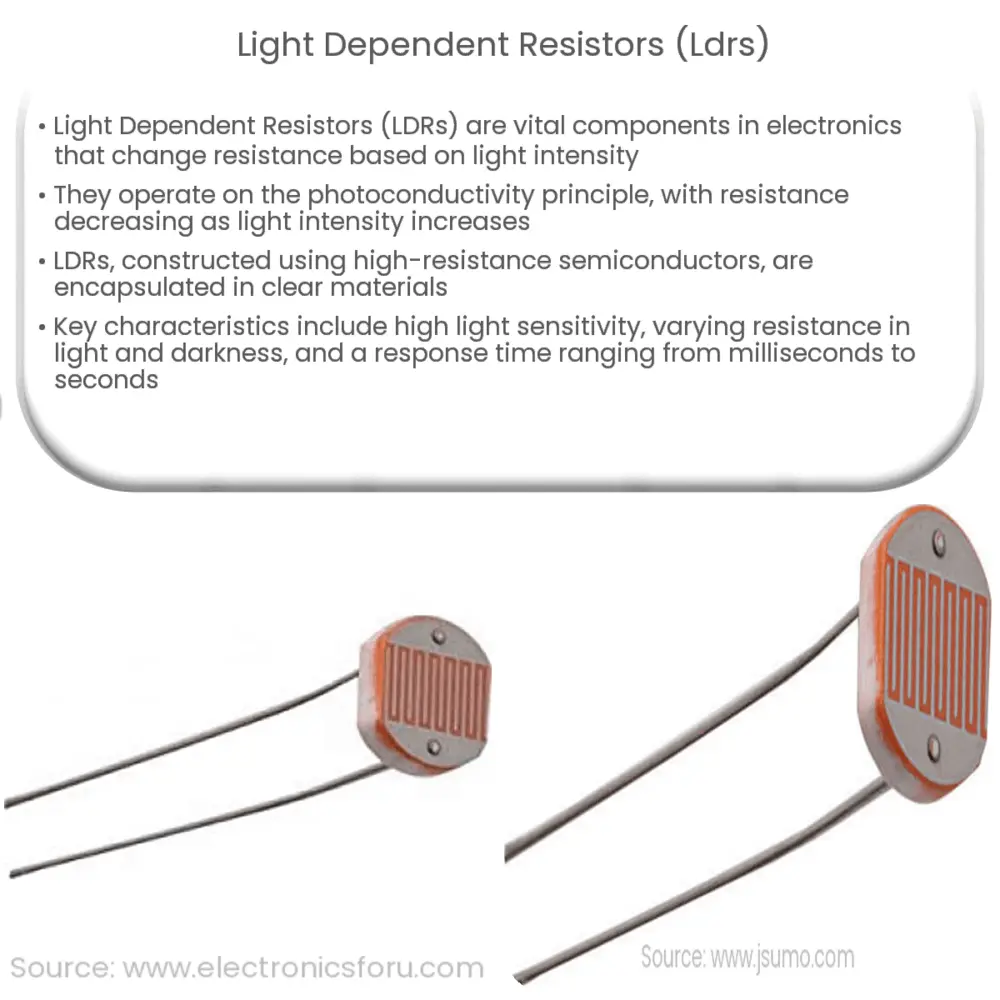Explore the world of Light Dependent Resistors (LDRs), their working principle, construction, key characteristics, applications, and advantages and disadvantages.

Introduction to Light Dependent Resistors (LDRs)
Light Dependent Resistors (LDRs), also known as photoresistors, are a crucial component in the world of electronic circuits. These components exhibit photoconductivity, which essentially means their resistance changes based on the intensity of light they are exposed to. In the absence of light, the LDR’s resistance is high, while in the presence of light, the resistance significantly decreases.
Working Principle of LDRs
The working principle of an LDR is based on the photoconductivity phenomenon. The principle states that the conductivity of some materials tends to change when exposed to different light intensities. The resistance of an LDR decreases with an increase in incident light intensity. When light photons fall on the LDR, they provide energy to the electrons, thereby moving them into the conduction band and leading to an increase in charge carriers that enhances conductivity.
Construction of LDRs
LDRs are built using high resistance semiconductors, such as lead sulfide (PbS) or cadmium sulfide (CdS). These materials are sandwiched between two ceramic plates. A wavy pattern is cut through the resistive material to create a long, serpentine path. This design increases the length of the path the current has to travel, thus increasing the resistance. LDRs are typically encapsulated in clear plastic or glass to protect the sensitive parts while allowing light to reach them.
Key Characteristics of LDRs
- Light Sensitivity: LDRs have high sensitivity to light. Their resistance changes significantly even with minor changes in light intensity.
- Dark Resistance: In the absence of light, LDRs exhibit a high resistance, typically in the MΩ range.
- Light Resistance: When exposed to light, the resistance of an LDR can drop to a few hundred ohms, depending on the light intensity.
- Response Time: LDRs do not instantly respond to changes in light intensity. They have a response time that can range from a few milliseconds to a few seconds.
Now that we understand the basics of Light Dependent Resistors, their construction, and key characteristics, in the next section, we’ll dive into their applications and how they’re used in various electronic devices.
Applications of LDRs
LDRs find widespread use in many electronic and electrical devices due to their unique properties. Here are some of the key applications:
- Light Detection: Due to their sensitivity to light, LDRs are commonly used in light detection circuits, such as burglar alarm systems, light intensity meters, and light-activated switches.
- Automatic Street Lighting: LDRs play a pivotal role in automated street lighting systems. As the intensity of sunlight decreases, the resistance of the LDR increases, triggering the lights to switch on.
- Photography: In photography, LDRs are used in light meters to measure the intensity of light. This helps photographers adjust their camera settings for optimal exposure.
- Astronomy: In telescopes, LDRs are used to calibrate the light levels for optimal viewing and imaging.
Advantages and Disadvantages of LDRs
Like any other electronic component, LDRs have their pros and cons:
- Advantages: LDRs are inexpensive, small in size, and offer high sensitivity to light. They also have a wide spectral response, and their non-invasive nature makes them suitable for a wide array of applications.
- Disadvantages: LDRs have a slower response time and less accuracy compared to other light sensors like photodiodes or phototransistors. They are also less reliable in extreme environmental conditions.
Conclusion
In conclusion, Light Dependent Resistors (LDRs) are a vital component in the world of electronics, with widespread use across various industries. Their unique property of changing resistance based on the intensity of light makes them an essential part of many light-sensitive applications. Despite their limitations, their cost-effectiveness, simplicity, and broad spectral response make them a preferred choice for many light detection applications. As technology evolves, we anticipate further enhancements in the design and functionality of LDRs, making them even more integral to future electronic and electrical systems.

